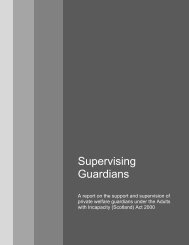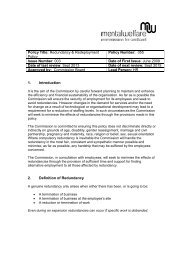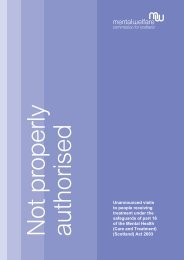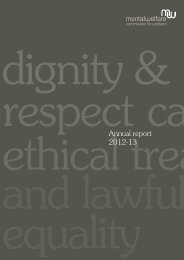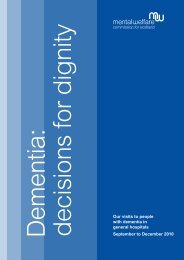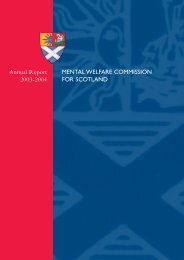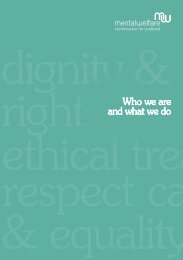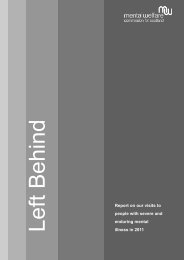Safe to wander - Mental Welfare Commission for Scotland
Safe to wander - Mental Welfare Commission for Scotland
Safe to wander - Mental Welfare Commission for Scotland
- No tags were found...
You also want an ePaper? Increase the reach of your titles
YUMPU automatically turns print PDFs into web optimized ePapers that Google loves.
7Assessment of riskAny assessment must includeanalysis of the risk that isbeing presented. This mustfocus on the risk <strong>to</strong> theindividual, not the organisationor care facility. Assessmentshould always take the viewsof the individual, <strong>for</strong>mal carersand involved relatives in<strong>to</strong>account. There should be acareful evaluation of the riskthat is presented and thelikelihood of that occurring.The risk <strong>to</strong> the individual ofany proposed interventionshould also be discussedand this would includepsychological as well asphysical safety concerns.Care establishments shouldhave written policies on careplanning and risk assessmentthat take in<strong>to</strong> account theperson’s need <strong>to</strong> exerciseand move freely.Alternatives <strong>to</strong> <strong>wander</strong>ingtechnologyBe<strong>for</strong>e considering the useof <strong>wander</strong>ing technologythere should be an appraisalof the interventions thathave been tried <strong>to</strong> date.This should <strong>for</strong>m part ofthe assessment process.People with dementia needappropriate stimulation andactivity. Individual care plansmust reflect this and willbenefit from input from askilled occupationaltherapist. A person withdementia who finds him orherself in an understimulatingenvironment, maywell explore in an attempt <strong>to</strong>find something moreinteresting or meaningful <strong>to</strong>do. It would be whollyinappropriate <strong>to</strong> use atechnology solution <strong>for</strong> thisbehaviour, unless greatattention is paid <strong>to</strong>appropriate, person centredoccupation and stimulation.The importance of dementiafriendlydesign, including thecreative use of outdoorspace should not beunderestimated althoughthere will obviously bephysical limitations in older,non-purpose built units.Ideally, buildings shouldprovide open access <strong>to</strong> safeoutdoor space. The internalenvironment must containdestinations that are ofinterest. Long corridorsleading <strong>to</strong> locked exit doorsmust be avoided.Small changes in practiceand environments can havesuccessful outcomes. Theimportance of exerciseshould be taken in<strong>to</strong> accountand incorporated in<strong>to</strong> the careplan as appropriate.The use of cloth panels <strong>to</strong>conceal doors or door knobs(which can be described as‘subjective barriers’ <strong>to</strong><strong>wander</strong>ing in that theyappear as an obstruction only<strong>to</strong> those who are cognitivelyimpaired) could offer a lessrestrictive option than alocked door.Another alternative <strong>to</strong><strong>wander</strong>ing technologyis the adaptation of nursingobservation policies <strong>to</strong> meetthe needs of the individualflexibly and when mostnecessary. Many individualsrequire increased levels ofobservation only at particulartimes of day and night,rather than having fixedobservation levels.




